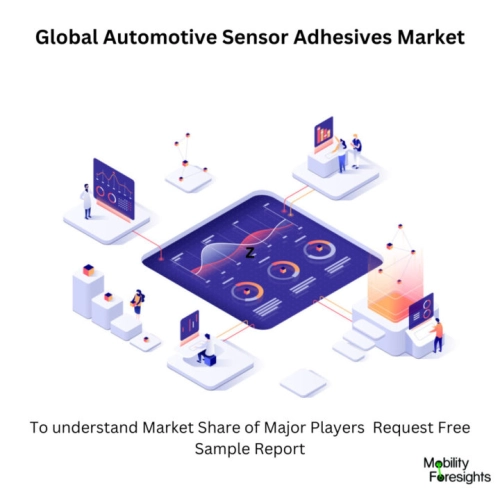
- Get in Touch with Us

Last Updated: Apr 25, 2025 | Study Period: 2024-2030
Automotive adhesives are used to join seats, spoilers, tailgates, side skirts, bumpers, headlamps, consoles, and other components.
They are also employed in the automotive sector to connect newer materials such coated metals, aluminum, and others.
A automotive sensor is an electronic gadget that keeps track of numerous features of the vehicle and transmits data to the driver or ECU (Electronic Control Unit). In some circumstances, the ECU automatically modifies the specific component based on data from the sensor.

The Global Automotive Sensor Adhesives market accounted for $XX Billion in 2023 and is anticipated to reach $XX Billion by 2030, registering a CAGR of XX% from 2024 to 2030.
A novel dual-cure adhesive sensor has been launched by Henkel that is intended exclusively for bonding applications in ADAS cameras and LiDAR modules for automobiles.
Loctite Able Stik NCA 3218 offers a solution for bonding applications such as lens barrel-to-housing and lens housing-to-circuit board by utilizing a distinctive UV cationic thermal dual-cure epoxy.
In order to comply with REACH, CMR, SVHC, and antimony-free requirements, Loctite Able Stik NCA 3218 was developed.
Dispensable, dual-cure, non-conductive adhesive Loctite Able Stik NCA 3218 has only one component. The interface is less strained as a result of its high glass transition temperature (Tg), which also allows for great adhesion to aluminum, PBT, and other polymers as well as PCB substrates.
As a result of its low coefficient of thermal expansion (CTE) and low and constant cure shrinkage, the amount of size change after curing is kept to a minimum.
Over the course of an ADAS sensor's lifespan, Loctite Able Stik NCA 3218 ensures long-term, strong, and reliable functionality.
Because it guarantees the best blocking to stop accidental light penetration and adds further quality assurance for the sensor, its grey color is also perfect for optical applications.
| Sl no | Topic |
| 1 | Market Segmentation |
| 2 | Scope of the report |
| 3 | Abbreviations |
| 4 | Research Methodology |
| 5 | Executive Summary |
| 6 | Introduction |
| 7 | Insights from Industry stakeholders |
| 8 | Cost breakdown of Product by sub-components and average profit margin |
| 9 | Disruptive innovation in the Industry |
| 10 | Technology trends in the Industry |
| 11 | Consumer trends in the industry |
| 12 | Recent Production Milestones |
| 13 | Component Manufacturing in US, EU and China |
| 14 | COVID-19 impact on overall market |
| 15 | COVID-19 impact on Production of components |
| 16 | COVID-19 impact on Point of sale |
| 17 | Market Segmentation, Dynamics and Forecast by Geography, 2024-2030 |
| 18 | Market Segmentation, Dynamics and Forecast by Product Type, 2024-2030 |
| 19 | Market Segmentation, Dynamics and Forecast by Application, 2024-2030 |
| 20 | Market Segmentation, Dynamics and Forecast by End use, 2024-2030 |
| 21 | Product installation rate by OEM, 2023 |
| 22 | Incline/Decline in Average B-2-B selling price in past 5 years |
| 23 | Competition from substitute products |
| 24 | Gross margin and average profitability of suppliers |
| 25 | New product development in past 12 months |
| 26 | M&A in past 12 months |
| 27 | Growth strategy of leading players |
| 28 | Market share of vendors, 2023 |
| 29 | Company Profiles |
| 30 | Unmet needs and opportunity for new suppliers |
| 31 | Conclusion |
| 32 | Appendix |